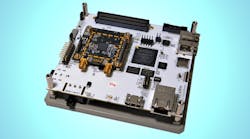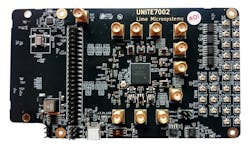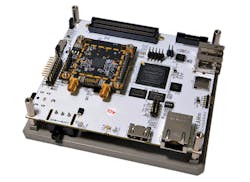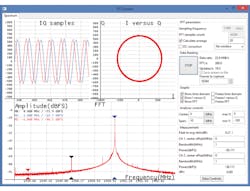This file type includes high resolution graphics and schematics when applicable.
Modern wireless product design usually involves simulation with software and measurements with test gear—and with construction of a printed-circuit-board (PCB) prototype in between. To speed the design process, a kit developed jointly by Lime Microsystems and Altera provides a head start on the RF and baseband circuitry. The Universal Radio Development Platform combines two PCBs and software, and allows new designs to be developed quickly and characterized inexpensively, without costly high-end test equipment.
One of the two circuit boards contained in the Universal Radio Development Platform kit is an RF/baseband subsystem. This board, the model UNITE7002 (Fig. 1), is built around Lime’s model LMS7002M dual-transceiver integrated circuit (IC).This field-programmable RF (FPRF) transceiver is fabricated with silicon CMOS semiconductor technology and covers a wide range of frequencies and wireless formats.
The IC incorporates two frequency mixers for frequency translation, along with complementary component functions. The latter includes low-noise amplifiers; filters; in-phase (I) and quadrature (Q) digital-to-analog converters (DACs); I and Q analog-to-digital converters (ADCs); and digital signal processors (DSPs). In spite of the number of components, the device achieves low-power operation through its CMOS technology and help from the DSPs, with the IC capable of operating on a single supply rail of +1.8 V dc.
The LMS7002M transceiver (and its board) is usable from 100 kHz to 3.8 GHz and is software-configured for RF bandwidths to 120 MHz. It supports second-generation (2G), third-generation (3G), and fourth-generation (4G) cellular communications standards with time-division-duplex (TDD) and frequency-division-duplex (FDD) techniques, along with numerous other wireless standards like Wi-Fi. The device is programmable, with parameters such as frequency, gain, filter characteristics, and bandwidth readily adjustable. The IC features a standard serial port interface (SPI) for programming and includes provision for a full RF calibration.
With its dual-transceiver architecture, the LMS7002M can create two transmit-and-receive signal paths and can handle 2 × 2 multiple-input, multiple-output (MIMO) system architectures. The transceiver’s enhanced capability features, such as an on-chip microcontroller, further simplify its calibration and installation. The LMS7002M IC is housed in a 261-pin QFN package measuring 11.5 × 11.5 mm.
The second PCB in the design kit, the Stream interconnect board (Fig. 2), includes a Cyclone IV FPGA from Altera, a model EP4CE40F23C7N. This low-power device fabricated with Altera’s low-power 28-nm process, is optimized for transceiver applications requiring reliable, low-cost operation. The Stream board offers a wide range of input/output (I/O) interconnect options, such as using an FPGA mezzanine card (FMC) connector together with high-definition-multimedia-input (HDMI) and Universal Serial Port (USB) connections.
The board employs a standardized interconnect scheme with an 80-pin surface-mount-technology (SMT) connector, which meets the requirements for the IEEE802.3ap backplane link. The connector was also used on some earlier LMS6002D boards from Lime, intended for future and backwards compatibility.
The LimeSuite RF design software that accompanies the two boards runs on a personal computer (PC) with Linux or Microsoft Windows operating systems. It features a simple graphical user interface (GUI) to program the FPRF and provide controls for the different FPGA configurations included with the design kit (Fig. 3). Operators can accept the standard configurations or change the control settings according to design requirements.
The FPRF GUI control allows users to download and test different sets of wireless communications parameters in real time. In some cases, the use of the downloaded test configurations to evaluate designs executed on the two PCBs can eliminate the need for external test equipment, with the related savings in development cost. In many cases, specialized test equipment like vector signal analyzers (VSAs) are not needed, and testing can be performed on a general-purpose signal analyzer.
Setting up the development kit is straightforward, involving a basic calibration process that is designed to achieve optimum performance. To further simplify the process, an on-chip microcontroller integrated in the LMS7002M transceiver IC can calibrate a number of performance parameters. These include DC offset; I/Q gain and phase mismatch in transmit-and-receive signal chains; transmit/receive lowpass-filter bandwidth tuning; and on-chip resistor and capacitor calibrations.
The on-chip microprocessor can also assist in achieving the close phase matching between channels required for MIMO system configurations. In addition, internal RF loopback signal paths can be used to test the effectiveness of a calibration process.
Testing the development kit with external equipment is a simple matter, since RF signals from the UNITE7002 board can be transferred directly to external test gear such as signal analyzers (Fig. 4). An example of such a test that can be performed with an external analyzer is a measurement of error vector magnitude (EVM), also known as receive constellation error (RCE). This is a measure of the accuracy of the constellation points on modulation schemes such as quadrature phase-shift keying (QPSK) or quadrature amplitude modulation (QAM).
The Universal Radio Development Platform kit and its two boards and software include various example system-level configurations, including MIMO architectures that can be downloaded to save engineering time. For engineers experimenting with wireless system approaches, this kit is a tremendous asset, and a way to truly gain a “head start” on a new system design.
Lime Microsystems, Surrey Tech Centre Occam Rd., The Surrey Research Park Guildford Surrey GU2 7YG; +44 (0) 1483 685 063, +44(0)1428 653 335, FAX: +44(0) 1428 656 662
This file type includes high resolution graphics and schematics when applicable.





